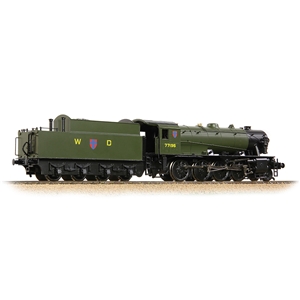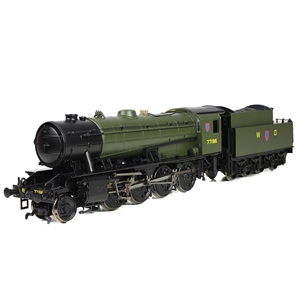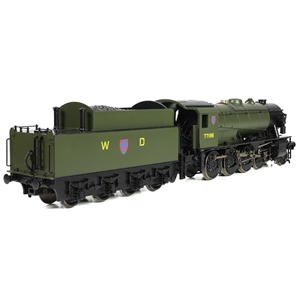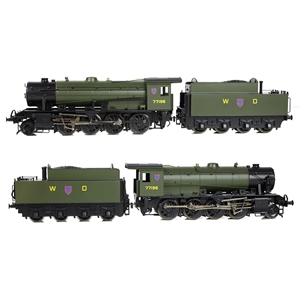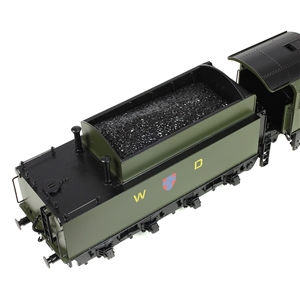You are here:
Bachmann 32-444SF OO Gauge Class 24/1 97201 Experiment Disc Headcode BR RTC (Original) Sound Fitted
Bachmann 32-444SF OO Gauge Class 24/1 97201 Experiment Disc Headcode BR RTC (Original) Sound Fitted
1 in stock
Description
Bachmann 32-444SF OO Gauge Class 24/1 97201 Experiment Disc Headcode BR RTC (Original) Sound Fitted
Product Number: 32-255B
Unit: Each
Scale/Gauge: OO
Era: 3
Manufacturer Product Code: 32-255B
Availability: Arrived
As part of our Winter 2022 British Railway Announcements, we are delighted to welcome the WD Austerity back to the Bachmann Branchline range. Depicting a locomotive in wartime use is No. 77196 in WD Khaki Green livery.
The WD 2-8-0 Austerity locomotives were some of the strongest freight locomotives to operate on Britain’s railways and the Branchline model conveys all the strength and power of the prototype, making it an imposing addition to any layout or collection. Featuring a wealth of detail, the uncomplicated appearance of the real locomotives is captured in miniature from the long, parallel boiler and smokebox arrangement to the large, angular tender. With a powerful drive train the WD Austerity is ready to handle the goods, whilst the 21 Pin DCC decoder socket and designated speaker space mean you can add sound for even more realism. If it’s realism you’re looking for, why not choose our SOUND FITTED model to enjoy sound straight from the box.
MODEL FEATURES:
- Bachmann Branchline OO Scale
- Era 3
- Pristine WD Khaki Green livery
- Running No. 77196
- Removable Coal Load with coal space modelled below
- Adjustable Tender Drawbar
- Accessory Pack
- NEM Coupling Pockets
- Sprung Buffers
- Powerful 3 Pole Motor
- Locomotive Ready to Accept a Speaker
- Equipped with a 21 Pin DCC Decoder Socket – recommended Decoder item No. 36-557
- Length 268mm
WD AUSTERITY HISTORY
The War Department (WD) “Austerity” 2-8-0 is a type of heavy freight steam locomotive that was introduced in 1943 for war service. Designed by R. A. Riddles, who had been appointed Director of Transport Equipment at the Ministry of Supply with the outbreak of World War Two, the WD Austerity met a clear demand for locomotives to aid the war effort in Europe.
Riddles based his new locomotive on the Stanier 8F, which he had adopted as the staple military goods locomotive during his time with the Ministry of Supply, and construction began in January 1943. The WD Austerity had many parts in common with the 8F but was given a simpler parallel boiler with a round-topped firebox. Low cost was prioritised over design life and cast metal parts were kept to a minimum as that material was in short supply for armoured fighting vehicles. There were a few problems with the design, most notably with regard to the firebox and its drop-grate mechanism, and many of the WD Austerities were adapted and fitted with improved parts following the war.
A total of 935 were built, making this one of the most numerous classes of British locomotive, but until the D-Day landings, the British Army had little use for the Austerities and as a result many were loaned out to the ‘Big Four’ railway companies. From June 1944 to February 1945, all of the initial locomotives were shipped to the Continent. Following the end of World War Two, the army proceeded to repatriate the Austerities, beginning in November 1945.
Now army surplus, the first company to step in was the LNER which purchased 200 of them at the end of 1946. These were reclassified as Class 07 in January of the following year. In 1948, 533 more were purchased by the British Transport Commission. With the formation of British Railways, the 733 locomotives were renumbered into the 90000–90732 series, and of these, 123 remained in service at the start of 1967. Two locomotives continued to be held in WD stock, seeing service on the Longmoor Military Railway in Hampshire. One WD 2-8-0 has survived in preservation at the Keighley & Worth Valley Railway.
Additional information
| Weight | 250 g |
|---|---|
| Brand | Bachmann |
| Condition | New |
| Scale | OO/HO Gauge |
| Format | Locomotive |
| Livery | Blue & Red, BR Research Department |
| Locomotive Class | Class 24/1 |
| Status | DCC Sound Fitted |
| Prime Power | Diesel |
| ERA | ERA 5 (1957-1966) |
| Decoder Type | 21 Pin |
| Finish | Pristine |
| Wheel Config | BoBo |
| Minimum Radius | Radius 2 |
| Operator | BR |
| Built By | BREL |
Related Products
Related products
-
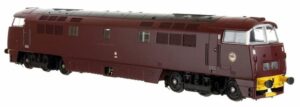
Dapol 4D-003-014S Diesel Loco Class 52 Western Harrier BR D1008 Digital Sound
£279.50Saving (£23.27)1 in stock
-
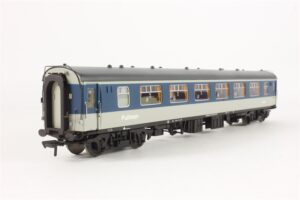
Bachmann 39-291A BR Mk1 FP Pullman parlour 1st Class Coach
£48.956 in stock
-

Bachmann 32-817SDDS Class 47 714 Anglia Railways DCC
£234.99Saving (£9.96)1 in stock
-
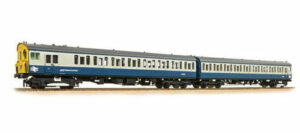
Bachmann 31-380 Class 416/2 2-EPB 2-Car EMU 6262 BR Blue & Grey (Network SouthEast)
£199.99Saving (£59.96)4 in stock
-
Sale!

Accurascale ACC2535CDA-DB1 CDA – DB – Pack 1
£74.95Original price was: £74.95.£69.99Current price is: £69.99.7 in stock


